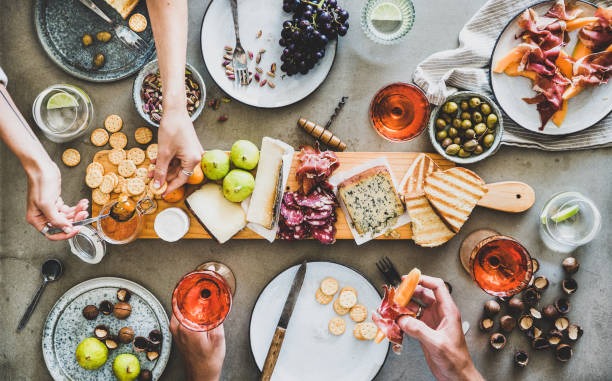A beautifully arranged charcuterie board is more than just a spread of meats and cheeses—it’s a curated experience that brings people together. Whether you’re hosting a dinner party, celebrating an occasion, or enjoying a cozy night in, a well-crafted charcuterie board can be both impressive and delicious. Here’s a step-by-step guide to building the perfect one.
Step 1: Choose Your Board
Start with a flat surface that’s large enough to hold a variety of items:
- Options: Wooden cutting board, slate, marble slab, or a large serving tray
- Tip: Use parchment paper underneath if you’re serving strong-smelling items
Step 2: Select a Variety of Meats
Pick 2 to 4 cured meats for diversity in texture and flavor:
- Salami (classic and widely loved)
- Prosciutto (thin and delicate)
- Chorizo (spicy and bold)
- Coppa or Soppressata (adds depth)
Presentation Tip: Fold or roll meats to create visual interest and make them easy to grab.
Step 3: Add 2–4 Cheeses
Balance flavors and textures with a mix of soft, semi-soft, and hard cheeses:
- Soft: Brie, Camembert, Goat Cheese
- Semi-soft: Havarti, Gouda, Fontina
- Hard: Aged Cheddar, Manchego, Parmesan
Tip: Pre-slice hard cheeses for easy serving; leave soft cheeses whole with a small knife.
Step 4: Include Fresh and Dried Fruits
Fruits provide sweetness and contrast:
- Fresh: Grapes, apple slices, berries, figs
- Dried: Apricots, cranberries, dates
They add color and pair beautifully with salty meats and cheeses.
Step 5: Add Crunch with Crackers and Bread
Choose a variety of textures:
- Artisan crackers
- Crostini or toasted baguette slices
- Breadsticks or pretzel thins
Tip: Keep them in clusters or small stacks for visual balance.
Step 6: Fill in with Nuts and Olives
Add a salty crunch and savory bite:
- Nuts: Almonds, walnuts, pistachios
- Olives: Castelvetrano, Kalamata, stuffed green olives
You can also include pickles or cornichons for tang.
Step 7: Sweet and Savory Spreads
Small bowls of spreads enhance the overall flavor experience:
- Sweet: Fig jam, honey, fruit preserves
- Savory: Mustard, tapenade, hummus
Tip: Place spreads in small ramekins or jars with mini spoons.
Step 8: Arrange with Intention
Start by placing bowls and cheeses, then layer in meats, fruits, and crackers. Fill gaps with nuts and small items to make the board look full and inviting.
Styling Tips:
- Use contrasting colors and textures.
- Spread out similar items for balance.
- Don’t be afraid to go asymmetrical—it often looks more natural.
Step 9: Consider Dietary Needs
Make sure to include vegetarian, gluten-free, or nut-free options depending on your guests.
Step 10: Serve at the Right Temperature
Let cheese and meats sit at room temperature for about 30 minutes before serving to enhance flavor and texture.
Final Touch: Garnish
Finish with fresh herbs like rosemary, thyme, or edible flowers for a touch of elegance.
Conclusion
A charcuterie board is as much about creativity and presentation as it is about taste. With thoughtful selection and arrangement, you can craft a board that’s visually stunning and crowd-pleasing. Customize it for the season, the event, or your personal preferences—and enjoy the art of delicious entertaining.





Leave a Reply